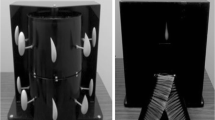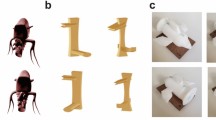Abstract
Visual imagery comprises object and spatial dimensions. Both types of imagery encode shape but a key difference is that object imagers are more likely to encode surface properties than spatial imagers. Since visual and haptic object representations share many characteristics, we investigated whether haptic and multisensory representations also share an object-spatial continuum. Experiment 1 involved two tasks in both visual and haptic within-modal conditions, one requiring discrimination of shape across changes in texture, the other discrimination of texture across changes in shape. In both modalities, spatial imagers could ignore changes in texture but not shape, whereas object imagers could ignore changes in shape but not texture. Experiment 2 re-analyzed a cross-modal version of the shape discrimination task from an earlier study. We found that spatial imagers could discriminate shape across changes in texture but object imagers could not and that the more one preferred object imagery, the more texture changes impaired discrimination. These findings are the first evidence that object and spatial dimensions of imagery can be observed in haptic and multisensory representations.



Similar content being viewed by others
References
Blajenkova O, Kozhevnikov M, Motes MA (2006) Object-spatial imagery: a new self-report imagery questionnaire. Appl Cognit Psychol 20:239–263
Kozhevnikov M, Hegarty M, Mayer RE (2002) Revising the visualiser-verbaliser dimension: evidence for two types of visualisers. Cogn Instruct 20:47–77
Kozhevnikov M, Kosslyn SM, Shephard J (2005) Spatial versus object visualisers: a new characterisation of cognitive style. Mem Cogn 33:710–726
Kozhevnikov M, Blazhenkova O, Becker M (2010) Trade-off in object versus spatial visualization abilities: restriction in the development of visual-processing resources. Psychon B Rev 17:29–35
Lacey S, Campbell C (2006) Mental representation in visual/haptic crossmodal memory: evidence from interference effects. Q J Exp Psychol 59:361–376
Lacey S, Sathian K (2011) Multisensory object representation: insights from studies of vision and touch. Prog Brain Res (in press)
Lacey S, Peters A, Sathian K (2007) Cross-modal object representation is viewpoint-independent. PLoS ONE 2:e890. doi:10.1371/journal.pone0000890
Lacey S, Pappas M, Kreps A, Lee K, Sathian K (2009a) Perceptual learning of view-independence in visuo-haptic object representations. Exp Brain Res 198:329–337
Lacey S, Tal N, Amedi A, Sathian K (2009b) A putative model of multisensory object representation. Brain Topogr 21:269–274
Lacey S, Hall J, Sathian K (2010) Are surface properties integrated into visuo-haptic object representations? Eur J Neurosci 30:1882–1888
Lawson R (2009) A comparison of the effects of depth rotation on visual and haptic three-dimensional object recognition. J Exp Psychol Human 35:911–930
Newell FN, Ernst MO, Tjan BS, Bülthoff HH (2001) View dependence in visual and haptic object recognition. Psychol Sci 12:37–42
Pecher D, van Dantzig S, Schifferstein HNJ (2009) Concepts are not represented by conscious imagery. Psychon B Rev 16:914–919
Acknowledgments
Support to KS from the National Eye Institute, the National Science Foundation, and the Veterans Administration is gratefully acknowledged.
Author information
Authors and Affiliations
Corresponding author
Appendix
Appendix
Self-report instructions
Research has shown that when people use visual imagery—imagining something in their mind’s eye—they usually prefer one of two kinds of imagery, either object imagery or spatial imagery.
Object imagers tend to have detailed pictorial images of objects and scenes that tend to concentrate on the literal appearance of objects, including color, texture, patterns, brightness etc., as well as shape. By contrast, spatial imagers tend to have more schematic images that concentrate on the shape of objects, their spatial layout in a scene, the spatial relationships between parts of an object, and how these are transformed. An easy way to think of this difference is the contrast between a photograph (object imagery) and blueprint or diagram (spatial imagery).
With this in mind, which kind of imagery do you think that you typically prefer: Are you an object imager or a spatial imager?
Rights and permissions
About this article
Cite this article
Lacey, S., Lin, J.B. & Sathian, K. Object and spatial imagery dimensions in visuo-haptic representations. Exp Brain Res 213, 267–273 (2011). https://doi.org/10.1007/s00221-011-2623-1
Received:
Accepted:
Published:
Issue Date:
DOI: https://doi.org/10.1007/s00221-011-2623-1




